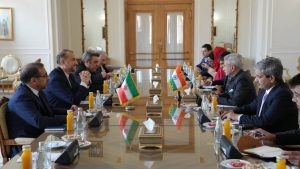The helicopter crash that claimed the life of Iranian President Ebrahim Raisi sent shockwaves through the corridors of power in Tehran, leaving a nation in mourning and a government in flux. The unexpected calamity has propelled Iran into a complex process of leadership transition, with the global community – and especially India – closely monitoring the potential changes in the nation’s diplomatic direction as new leadership emerges.
The Chabahar Agreement, signed by the transport ministers of India, Iran, and Afghanistan in May 2016, is under new scrutiny. The leadership transition following Raisi’s death could lead to a re-evaluation of Iran’s international commitments, including its partnership with India on Chabahar. This change introduces a layer of unpredictability that could affect the operational and strategic aspects of the port.
The pact inked between India Ports Global Ltd (IGPL) and Iran’s Ports and Maritime Organization (PMO) on May 13, 2024, is a bold statement of mutual commitment, even as political tides turn. PMO will procure essential cargo handling equipment for the India-funded Chabahar port on behalf of IPGL. The purchase cost will be refunded to the Iranian entity in United Arab Emirates dirhams, as part of a ten-year deal signed by the two countries. This agreement aims to kick start full-fledged operations at the port, which India has strategically secured.
IPGL has committed to raise its investment from the initial $85 million to $120 million for procuring equipment at the Chabahar port. Of the total agreed investment, IPGL has already utilized $85.21 million to purchase and install six mobile harbor cranes. These transactions were facilitated through state-owned UCO Bank, which has minimal exposure to the United States, mitigating potential sanctions risks. Thus, amid the swirling uncertainties of Iranian politics, the Chabahar port emerges as a beacon of continuity.
Nestled on the Gulf of Oman’s azure shores, the Chabahar port stands as a testament to the symbiotic relationship between India and Iran. More than a mere docking point, it is a lifeline that connects India’s ambitions to the heart of Central Asia through Afghanistan, circumventing the tumultuous terrain of Pakistan.
Additionally, Chabahar is poised to integrate with the International North-South Transport Corridor (INSTC), which spans from Russia to India. The INSTC involves collaboration among India, Russia, Iran, and other nations, including Azerbaijan, Armenia, Kazakhstan, Kyrgyzstan, Tajikistan, Turkey, Ukraine, Syria, Belarus, and Oman. This multimodal corridor combines rail and sea transport, presenting an alternative to China’s Belt and Road Initiative and the China-Pakistan Economic Corridor.
Chabahar is more than a port; it is India’s countermove to China’s maritime advances in Pakistan’s Gwadar. India’s investment in Chabahar’s development, a venture with economic promise, also navigates the choppy waters of geopolitical unrest. Any disruption in Chabahar’s progress could tilt the regional balance of power, granting China an unobstructed path to dominance. India’s resolve, embodied in the recent agreement, must now weather the potential hesitance of its businesses to anchor further in Iranian waters.
In the wake of leadership upheaval in Iran, the enduring alliance between India and Iran concerning the Chabahar port is poised to remain steady. The strategic foundations of this partnership are deeply interwoven with the mutual geopolitical and economic interests that both nations share. As Iran stands on the cusp of electing a new leader, it is imperative for India to maintain a vigilant and flexible stance, ready to adapt and ensure the continued success of its strategic initiatives in the Persian landscape.
Simultaneously, India’s proactive engagement in discussions to revisit the waiver clauses for the Chabahar port with its strategic partner, the United States, holds immense potential for broader regional welfare. As highlighted by External Affairs Minister S. Jaishankar, this visionary approach transcends narrow interests, benefiting not only Iran but also fostering a larger canvas of regional development and cooperation.
Amid the stormy seas of leadership change, Iran’s Chabahar port remains a guiding star, illuminating the path through the fog of geopolitical uncertainty. India’s unwavering commitment to this strategic haven symbolizes a promise of stability and progress. As the shadow of U.S. sanctions and Iran’s economic challenges loom, the destiny of Chabahar could reshape regional dynamics. Will this port weather the tempest or be swept away by the waves of unpredictability? The international community watches closely as India’s forthcoming strategies could shape the geopolitical terrain of Asia.
































